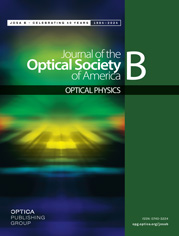JOSA B Feature Announcement
Photon-number-resolving Detectors for Quantum-state Engineering
Submissions Open: 1 April 2014
Submission Deadline: 15 June 2014
For this feature issue of the Journal of the Optical Society of America B, the Guest Editors will solicit authors from active groups using photon-number-resolving detectors. This feature issue is also open to all outside contributions in this area.
Generation and measurement of quantum states of the electromagnetic field represent a hot and widely discussed topic in the physical community, since optical states are useful not only in fundamental experiments but also in several applications in the fields of Quantum Optics and Quantum Information. In fact, optical radiation is endowed with relevant characteristics as it travels at maximum possible speed. It is almost unaffected by the interaction with the environment, which in many cases represents an unavoidable decoherence source, and it can be integrated in optoelectronic circuits to implement quantum computing protocols.
The possibility of using optical fields in applicative protocols depends on the capability of generating and manipulating optical states that are robust with respect to losses (i.e. that contain a sizeable number of photons) and that can be produced and addressed at high rates.
For all these reasons, mesoscopic pulsed optical states containing few photons per pulse seem to be the ideal candidates for applications to quantum communication protocols in which each pulse must be addressed individually.
As a matter of fact, measuring and manipulating pulsed optical states in the mesoscopic intensity regime is not straightforward, as detectors endowed with photon-number resolution are required so as to determine shot-by-shot photon numbers. Moreover, most protocols are based on conditional measurements performed on bipartite or multipartite correlated states, in which one component of the state is selected according to a rule set on the other: typical rules consist in selecting pulses containing a definite number of photons so as to generate nonGaussian and possibly sub-Poissonian conditional states.
Several different strategies are being followed to build new detectors and new detection techniques to accomplish the difficult task of measuring photon numbers. Among them we mention microcalorimeters (transition-edge sensor), superconducting detectors (nanowires), photoemissive detectors with partial photon-number resolution (photomultiplier tubes, hybrid photodetectors), detectors based on splitting of the light to be measured either in space or in time prior to detection so that at most one photon at a time hits the detector sensitive area (intensified CCD cameras, multipixel and/or position sensitive single-photon detectors, spatial splitting or single-photon avalanche photodiodes temporal splitting).
Manuscripts must be prepared according to the usual standards for submission to JOSA B. Manuscripts must also be uploaded through OSA's electronic submission system. All manuscripts must be submitted to the JOSA B. Please specify that the manuscript is for the Photon-number-resolving Detectors for Quantum-state Engineering feature (choose from the feature issue drop-down menu).
Feature Issue Editors
Alessia Allevi, University of Insubria
Maria Bondani, National Research Council—CNR (Lead)
Ondřej Haderka, Palacký University

